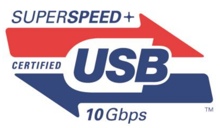USB speed upped to 10Gbps with new 3.1 standard

In a response to demand for more speed, the humble but ubiquitous USB receives a much-needed performance boost.

The performance bump to 10 Gbps, which was first announced in January, takes the standard to USB 3.1.
SuperSpeed USB 10 Gbps makes use of a more efficient data encoding system and delivers more than double the effective data throughput rate of existing SuperSpeed USB. However, the new standard is fully backward compatible with existing USB connectors and cables.
Also, according to the USB Implementers Forum, compatibility with existing USB 3.0 software stacks and device class protocols is guaranteed, as well as with existing 5 Gbps hubs and devices and USB 2.0 products.
"The USB 3.1 specification primarily extends existing USB 3.0 protocol and hub operation for speed scaling along with defining the next higher physical layer speed as 10 Gbps," said Brad Saunders, USB 3.0 Promoter Group Chairman. "The specification team worked hard to make sure that the changes made to support higher speeds were limited and remained consistent with existing USB 3.0 architecture to ease product development."
Even Intel, which is pushing its own Thunderbolt technology, is happy with the announcement.
"The industry has affirmed the strong demand for higher through-put, for user-connected peripherals and docks, by coming together to produce a quality SuperSpeed USB 10 Gbps specification," said Alex Peleg, Vice President, Intel Architecture Group. "Intel is fully committed to deliver on this request."